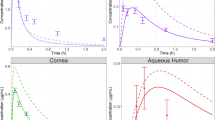Abstract
Purpose
To establish bioequivalence for topical ophthalmic corticosteroid suspensions, some of U.S. product-specific guidances (PSGs) for generic drug products recommend evaluation of aqueous humor (AH) pharmacokinetics (PK). However, the AH PK study is complex because the relationships among AH PK, subject demographics, ocular anatomy, physiology and the compounds’ physicochemical characteristics are not well understood. The objective of this research is to provide an overview of the in vivo human AH studies submitted to the U.S. Food and Drug Administration (FDA) for ophthalmic corticosteroid suspensions and to investigate the impact of subject demographics on the human AH PK.
Methods
We summarized demographic data, sampling time points, sample size per time point and PK parameters to investigate correlations in the studies submitted to the FDA.
Results
In the evaluation of subject-specific covariates, the area under the concentration-time curves (AUC) and maximum concentrations (Cmax) were significantly different among ethnicities and age groups. Gender was not primarily associated with differences in AH PK.
Conclusions
Our results suggest that the difference in ethnicity and age of the study population play an important role in the AH PK profiles of topical ophthalmic corticosteroid suspensions. Considering the subject-specific covariate effects in designing bioequivalence studies with AH PK endpoints could reduce bias from covariate imbalance and help identify true effects of formulation differences.

Similar content being viewed by others
References
Ghate D, Edelhauser HF. Ocular drug delivery. Expert Opin Drug Deliv. 2006;3(2):275–87.
Edelhauser HF, Maren TH. Permeability of human cornea and sclera to sulfonamide carbonic anhydrase inhibitors. Arch Ophthalmol (Chicago, Ill : 1960). 1988;106(8):1110–5.
Durairaj C. Ocular Pharmacokinetics. Handb Exp Pharmacol. 2017;242:31–55.
Ahmed I, Patton TF. Importance of the noncorneal absorption route in topical ophthalmic drug delivery. Invest Ophthalmol Vis Sci. 1985;26(4):584–7.
Gaudana R, Ananthula HK, Parenky A, Mitra AK. Ocular drug delivery. AAPS J. 2010;12(3):348–60.
Alm A, Nilsson SF. Uveoscleral outflow--a review. Exp Eye Res. 2009;88(4):760–8.
Kang-Mieler JJ, Osswald CR, Mieler WF. Advances in ocular drug delivery: emphasis on the posterior segment. Expert Opin Drug Deliv. 2014;11(10):1647–60.
Baranowski P, Karolewicz B, Gajda M, Pluta J. Ophthalmic drug dosage forms: characterisation and research methods. Sci World J. 2014;2014:861904.
FDA. Product-Specific Guidances for Generic Drug Development 2017 [Available from: http://www.fda.gov/Drugs/GuidanceComplianceRegulatoryInformation/Guidances/ucm075207.htm.
Choi SH, Lionberger RA. Clinical, pharmacokinetic, and in vitro studies to support bioequivalence of ophthalmic drug products. AAPS J. 2016;18(4):1032–8.
Kozak D WY. OGD citizen petition consult response memorandum (DRAFT). 2016.
Shen M, Machado SG. Bioequivalence evaluation of sparse sampling pharmacokinetics data using bootstrap resampling method. J Biopharm Stat. 2017;27(2):257–64.
Blake CR, Lai WW, Edward DP. Racial and ethnic differences in ocular anatomy. Int Ophthalmol Clin. 2003;43(4):9–25.
Agrahari V, Mandal A, Agrahari V, Trinh HM, Joseph M, Ray A, et al. A comprehensive insight on ocular pharmacokinetics. Drug Deliv Transl Res. 2016;6(6):735–54.
Wang D, Amoozgar B, Porco T, Wang Z, Lin SC. Ethnic differences in lens parameters measured by ocular biometry in a cataract surgery population. PLoS One. 2017;12(6):e0179836.
Zore M, Harris A, Tobe LA, Siesky B, Januleviciene I, Behzadi J, et al. Generic medications in ophthalmology. Br J Ophthalmol. 2013;97(3):253–7.
Jonas JB, Iribarren R, Nangia V, Sinha A, Pardhi P, Shukla R, et al. Lens position and age: the Central India eye and medical study. Invest Ophthalmol Vis Sci. 2015;56(9):5309–14.
Chen RI, Barbosa DT, Hsu CH, Porco TC, Lin SC. Ethnic differences in trabecular meshwork height by optical coherence tomography. JAMA Ophthalmol. 2015;133(4):437–41.
Chang SW, Hu FR. Changes in corneal autofluorescence and corneal epithelial barrier function with aging. Cornea. 1993;12(6):493–9.
Goel M, Picciani RG, Lee RK, Bhattacharya SK. Aqueous humor dynamics: a review. Open Ophthalmol J. 2010;4:52–9.
Pleyer U, Ursell PG, Rama P. Intraocular pressure effects of common topical steroids for post-cataract inflammation: are they all the same? Ophthalmol Therapy. 2013;2(2):55–72.
Moss EB, Buys YM, Low SA, Yuen D, Jin YP, Chapman KR, et al. A randomized controlled trial to determine the effect of inhaled corticosteroid on intraocular pressure in open-angle Glaucoma and ocular hypertension: the ICOUGH study. J Glaucoma. 2017;26(2):182–6.
Sheppard JD, Comstock TL, Cavet ME. Impact of the topical ophthalmic corticosteroid Loteprednol Etabonate on intraocular pressure. Adv Ther. 2016;33(4):532–52.
Roy B, Riley C, Herrin J, Spatz ES, Arora A, Kell KP, et al. Identifying county characteristics associated with resident well-being: a population based study. PLoS One. 2018;13(5):e0196720.
Green SB, Byar DP. The effect of stratified randomization on size and power of statistical tests in clinical trials. J Chronic Dis. 1978;31(6–7):445–54.
Wellek S, Blettner M. On the proper use of the crossover design in clinical trials: part 18 of a series on evaluation of scientific publications. Dtsch Arztebl Int. 2012;109(15):276–81.
Author information
Authors and Affiliations
Corresponding author
Additional information
Guest Editors: Hovhannes J Gukasyan, Shumet Hailu, and Thomas Karami
Disclaimer
This article reflects the views of the authors and should not be construed to represent the views or policies of the FDA.
Rights and permissions
About this article
Cite this article
Harigaya, Y., Jiang, X., Zhang, H. et al. Bioequivalence Study Methods with Pharmacokinetic Endpoints for Topical Ophthalmic Corticosteroid Suspensions and Effects of Subject Demographics. Pharm Res 36, 13 (2019). https://doi.org/10.1007/s11095-018-2537-8
Received:
Accepted:
Published:
DOI: https://doi.org/10.1007/s11095-018-2537-8




